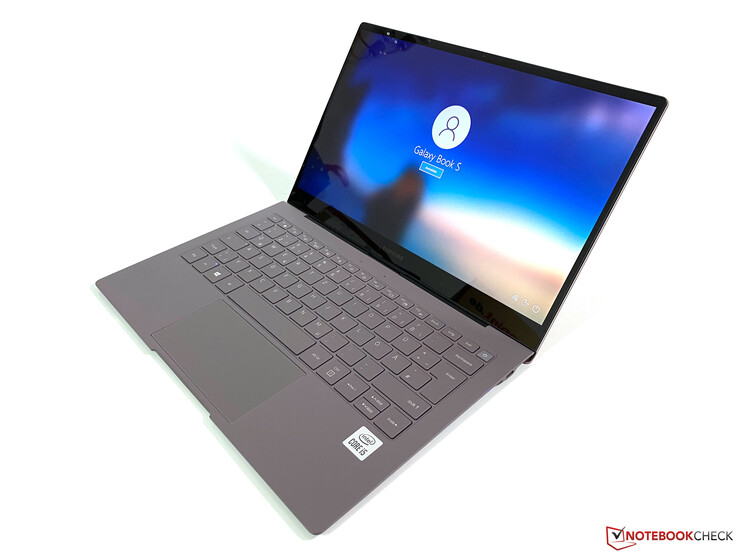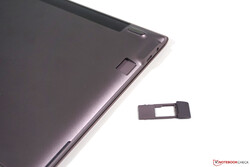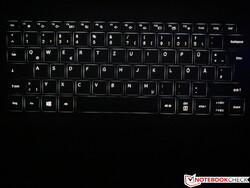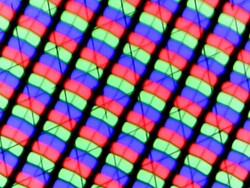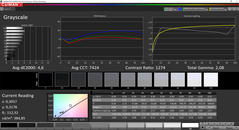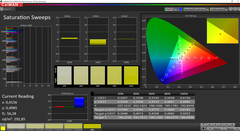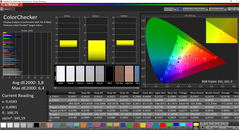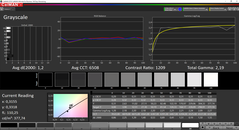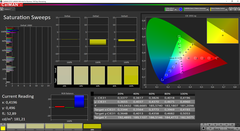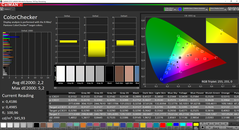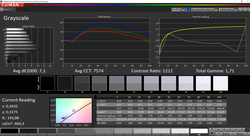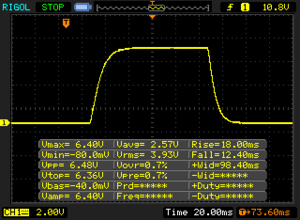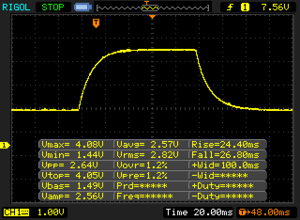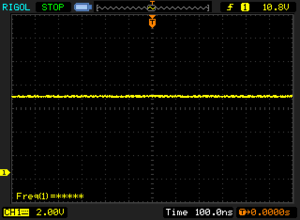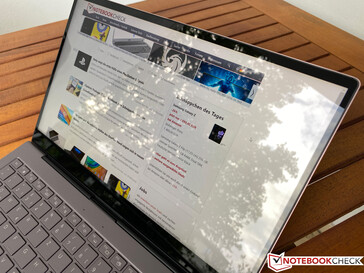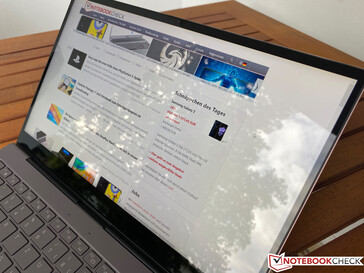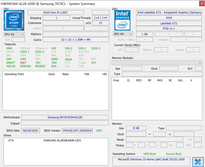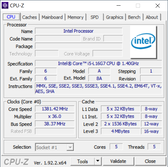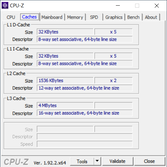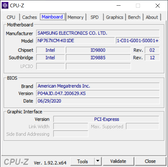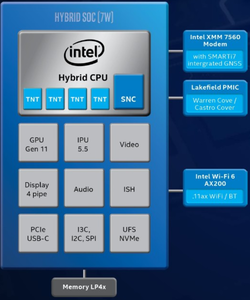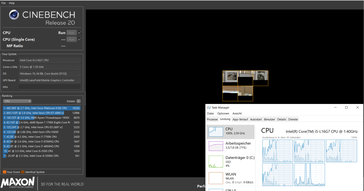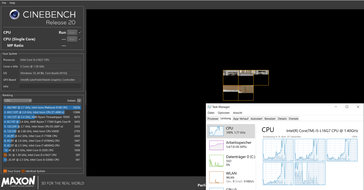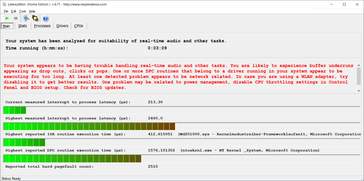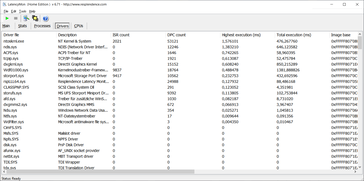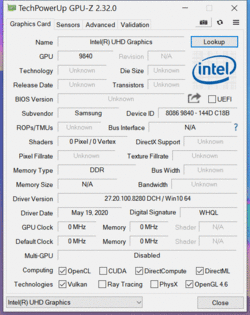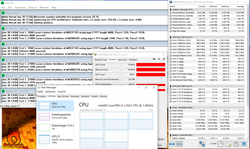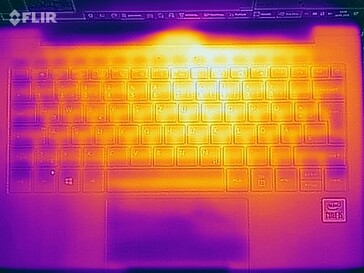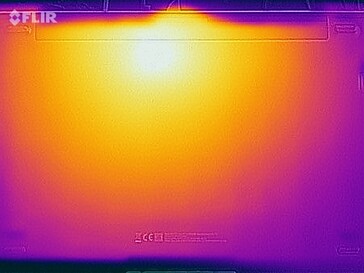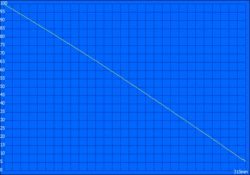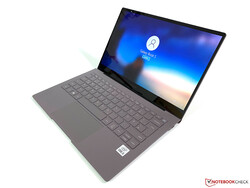Samsung Galaxy Book S Laptop İnceleme: İlk sorunları ile Lakefield
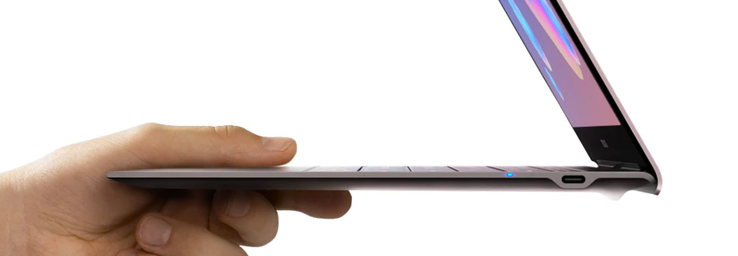
Samsung Galaxy Book S'yi yakın zamanda ARM işlemcisi ile inceledik ve Güney Koreli üretici şimdi kompakt ultrabook'unu Intel işlemciyle sunuyor. Bir kez daha tamamen pasif olarak soğutulan yepyeni Lakefield hibrit çip. Bununla birlikte, Intel modeli artık tüm bölgelerde bir LTE modemi içermiyor ve pil çalışma süreleri de daha kısa. X86 karşılığında uyumluluğu artırır. İki sürüm neredeyse benzer şekilde fiyatlandırılmıştır, bu nedenle hangi cihazın daha iyi olduğunu bulmak istiyoruz. Samsung'un resmi çevrimiçi mağazasından ünitemizi satın aldık, bu yüzden üreticiden seçilen bir basın örneği değil, düzenli bir perakende birim. 1129 Euro (~ 1275 $) fiyatla, Intel Lakefield işlemci, 8 GB RAM ve 256 GB depolama alanına sahip olursunuz. 1080p dokunmatik ekran da temelde aynıdır, ancak Samsung, Intel SKU'yu, parlaklığı 600 cd / m²'ye çıkarması beklenen özel bir Dış Mekan modu ile donatıyor. Kasa, portlar, hoparlörler ve giriş cihazları ( (arka plan aydınlatmasının rengi hariç) son incelenen ARM versiyonuyla aynıdır. Aşağıdaki incelemede iki modelin farklılıklarına odaklanacağız ve yeni Intel işlemciye daha yakından bakacağız.Not: Alman inceleme birimi bir LTE modemle donatılmadı, ancak diğer ülkelerde de yer alıyor. Bu nedenle, eksik LTE modemi ile ilgili inceleme bölümleri tüm bölgeleri temsil etmemektedir.
Derecelendirme | Tarih | Modeli | Ağırlık | Yükseklik | Boyut | Çözünürlük | Fiyat |
|---|---|---|---|---|---|---|---|
| 85.1 % v7 (old) | 07/2020 | Samsung Galaxy Book S Intel i5-L16G7, UHD Graphics G7 (Lakefield GT2 64 EU) | 940 g | 11.8 mm | 13.30" | 1920x1080 | |
| 86.2 % v7 (old) | 09/2019 | Samsung Galaxy Book S SD 8cx, Adreno 680 | 951 g | 11.8 mm | 13.30" | 1920x1080 | |
| 89.6 % v7 (old) | 06/2020 | Apple MacBook Air 2020 i3 i3-1000NG4, Iris Plus Graphics G4 (Ice Lake 48 EU) | 1.3 kg | 16.1 mm | 13.30" | 2560x1600 | |
| 88.8 % v7 (old) | 03/2020 | Dell XPS 13 9300 i5 FHD i5-1035G1, UHD Graphics G1 (Ice Lake 32 EU) | 1.2 kg | 14.8 mm | 13.40" | 1920x1200 | |
| 85.9 % v7 (old) | 06/2020 | Acer Swift 3 SF313-52-52AS i5-1035G4, Iris Plus Graphics G4 (Ice Lake 48 EU) | 1.2 kg | 16.6 mm | 13.50" | 2256x1504 | |
| 84 % v7 (old) | 03/2020 | Microsoft Surface Laptop 3 13 Core i5-1035G7 i5-1035G7, Iris Plus Graphics G7 (Ice Lake 64 EU) | 1.3 kg | 14.5 mm | 13.50" | 2256x1504 |
Kasa - Intel SKU da 1 kg'ın altında
Galaxy Book S'nin Intel sürümü 940 gramda biraz daha hafif, ancak doğrudan karşılaştırmada bile fark edilmiyor. Kompakt güç adaptörüyle (USB-C kablosu dahil 91 gram / 3,2 oz) toplam seyahat ağırlığı hala 1 kg'ın (~ 2,2 lb) biraz üzerindedir.
Top 10
» Top 10 Multimedia Notebook listesi
» Top 10 oyun notebooku
» Top 10 bütçeye uygun Ofis/İş Notebook Listesi
» Top 10 Premium Ofis/İş notebookları
» Top 10 Çalışma istasyonu laptopları
» Top 10 Subnotebook listesi
» Top 10 Ultrabooklar
» En iyi 10 dönüştürülebilir modeli
» Seçimi en iyi 10 tablet
» Notebookcheck Top 10 Windows Tabletleri
» Top 10 Subnotebook listesi
» NotebookCheck tarafından incelenen en iyi Notebook ekranları
» Notebookcheck'in 500 Euro altındaki en iyi 10 Notebook listesi
» NotebookCheck tarafından seçilen 300 Euro altındaki en iyi 10 Notebook
» Notebookcheck'in 500 Euro altındaki en iyi 10 Notebook listesi
» Notebookcheck'in Top 10 akıllı telefon listesi
» Notebookcheck'in Top 10 hafif oyun notebookları
Bağlantı - Wi-Fi 6 özellikli Galaxy Book S
Bağlantı noktaları, Galaxy Book S'nin ARM sürümü ile aynıdır. Her iki tarafta da dizüstü bilgisayarı şarj etmek için kullanılabilecek bir USB-C bağlantı noktası vardır (USB 3.1 Gen.1 w / DisplayPort-Alt). Ayrıca 3,5 mm stereo jak ve microSD okuyucu da edinebilirsiniz. Toshiba (Exceria Pro M501 64 GB UHS-II) referans kartımızla birlikte maksimum aktarım hızı 82,4 MB / s'dir, bu nedenle ARM modeliyle aynıdır. Resimleri kopyaladığınızda ortalama aktarım hızı 63,9 MB / s'de biraz daha düşüktür.Samsung Alman modelini bir LTE modemi ile göndermez, bu nedenle ARM SKU'nun en büyük avantajlarından biri gitti. Buna karşılık, müşteriler Intel'den (AX200) biraz daha hızlı bir Wi-Fi 6 modülü alıyorlar, ancak Netgear yönlendiricimiz (Nighthawk AX12) ile birlikte aktarım oranları beklentilerimizin altında. Sonuçlar ARM Galaxy Book S ile karşılaştırıldığında daha iyidir, ancak çoğu kullanıcı muhtemelen farkı fark etmeyecektir.
| SD Card Reader | |
| average JPG Copy Test (av. of 3 runs) | |
| Dell XPS 13 9300 i5 FHD (Toshiba Exceria Pro M501 64 GB UHS-II) | |
| Samsung Galaxy Book S (Toshiba Exceria Pro M501 64 GB UHS-II) | |
| Samsung Galaxy Book S Intel (Toshiba Exceria Pro M501 64 GB UHS-II) | |
| Sınıf ortalaması Subnotebook (18.4 - 142, n=13, son 2 yıl) | |
| maximum AS SSD Seq Read Test (1GB) | |
| Dell XPS 13 9300 i5 FHD (Toshiba Exceria Pro M501 64 GB UHS-II) | |
| Samsung Galaxy Book S (Toshiba Exceria Pro M501 64 GB UHS-II) | |
| Samsung Galaxy Book S Intel (Toshiba Exceria Pro M501 64 GB UHS-II) | |
| Sınıf ortalaması Subnotebook (22.5 - 207, n=13, son 2 yıl) | |
Giriş Aygıtları - Klavye aydınlatması hala zor kullanılabilir
Giriş aygıtları yakın zamanda gözden geçirilmiş ARM modeliyle aynıdır. Bununla birlikte, Dünyevi Altın'daki test birimimizin yeşil klavye aydınlatması değil, beyaz bir aydınlatması var. Temel sorun yine de aynıdır, çünkü arka ışık sağ alt ekran çerçevesine oturan bir sensör tarafından kontrol edilir. Sensör aydınlatmayı yalnızca neredeyse siyah renkte olduğunda etkinleştirir ve loş ortamlarda etkinleştiremezdik. Klavyenin görünürlüğü de renk nedeniyle mükemmel değil ve birçok durumda manuel kontrol istedik. Aydınlatma da biraz daha güçlü olabilir. Samsung bu sorunu kesinlikle çözmelidir.
Ekran - Dış Mekan Modu çok daha parlak
Özelliklere hızlı bir bakış, Samsung'un aynı 1080p dokunmatik ekranı kullandığını ve ölçüm sonuçlarımızın da çoğunlukla benzer olduğunu gösteriyor, ancak iki önemli fark var: Intel SKU, parlaklığı artıran Dış Mekan modunu destekliyor. ~ 650 cd / m². Herhangi bir PWM titremesini de tespit edemiyoruz, bu da ARM Galaxy Book S'de olduğu gibi. Bu nedenle, farklı bir panel gibi görünüyor (ARM modelinde tam panel kimliğini bulamadık). ARM modeline benzer şekilde, öznel resim izlenimi çok iyi. Entegre parlaklık sensörü yalnızca klavye aydınlatmasını kontrol eder; Not: Samsung, Dış Mekan modunun parlaklığı önemli ölçüde artıracağını ve bu da güç tüketimini artıracağını söylüyor. Dış mekan modu, örneğin ekranı kapattığınızda veya kapağı kapattığınızda da otomatik olarak devre dışı bırakılır. Modu her zaman manuel olarak etkinleştirmeniz gerekir, bu nedenle derecelendirmemiz için sonuçları (hem güç tüketimi hem de pil çalışma süresi için) Dış Mekan modu olmadan kullanırız.
| |||||||||||||||||||||||||
Aydınlatma: 88 %
Batarya modunda parlaklık: 387 cd/m²
Kontrast: 1283:1 (Siyah: 0.3 cd/m²)
ΔE ColorChecker Calman: 3.8 | ∀{0.5-29.43 Ø4.78}
calibrated: 2.2
ΔE Greyscale Calman: 4.6 | ∀{0.09-98 Ø5}
97.2% sRGB (Argyll 1.6.3 3D)
65.3% AdobeRGB 1998 (Argyll 1.6.3 3D)
71.3% AdobeRGB 1998 (Argyll 3D)
97.2% sRGB (Argyll 3D)
70% Display P3 (Argyll 3D)
Gamma: 2.2
CCT: 7424 K
| Samsung Galaxy Book S Intel BOE07E7, IPS, 1920x1080, 13.3" | Samsung Galaxy Book S BOE, IPS, 1920x1080, 13.3" | Apple MacBook Air 2020 i3 APPA042, IPS, 2560x1600, 13.3" | Dell XPS 13 9300 i5 FHD SHP14CB, IPS, 1920x1200, 13.4" | Acer Swift 3 SF313-52-52AS BOE08BC, IPS, 2256x1504, 13.5" | Microsoft Surface Laptop 3 13 Core i5-1035G7 Sharp LQ135P1JX51, IPS, 2256x1504, 13.5" | |
|---|---|---|---|---|---|---|
| Display | 0% | 2% | 1% | -3% | ||
| Display P3 Coverage (%) | 70 | 70.3 0% | 71.5 2% | 70.3 0% | 65.7 -6% | |
| sRGB Coverage (%) | 97.2 | 98 1% | 99.4 2% | 99.8 3% | 98.6 1% | |
| AdobeRGB 1998 Coverage (%) | 71.3 | 71.6 0% | 73.5 3% | 71.3 0% | 67.8 -5% | |
| Response Times | 6% | 16% | -13% | 0% | -27% | |
| Response Time Grey 50% / Grey 80% * (ms) | 51.2 ? | 48.8 ? 5% | 38.4 ? 25% | 60 ? -17% | 50 ? 2% | 59.2 ? -16% |
| Response Time Black / White * (ms) | 30.4 ? | 28.4 ? 7% | 28.4 ? 7% | 33.2 ? -9% | 31 ? -2% | 41.6 ? -37% |
| PWM Frequency (Hz) | 9524 ? | 119000 ? | 2500 ? | 192 ? | 21740 ? | |
| Screen | 2% | 29% | 17% | 6% | 23% | |
| Brightness middle (cd/m²) | 385 | 383 -1% | 416 8% | 619 61% | 456 18% | 403.4 5% |
| Brightness (cd/m²) | 354 | 355 0% | 403 14% | 591 67% | 432 22% | 397 12% |
| Brightness Distribution (%) | 88 | 88 0% | 95 8% | 91 3% | 88 0% | 89 1% |
| Black Level * (cd/m²) | 0.3 | 0.36 -20% | 0.34 -13% | 0.35 -17% | 0.32 -7% | 0.34 -13% |
| Contrast (:1) | 1283 | 1064 -17% | 1224 -5% | 1769 38% | 1425 11% | 1186 -8% |
| Colorchecker dE 2000 * | 3.8 | 3.1 18% | 0.9 76% | 3 21% | 3.49 8% | 0.94 75% |
| Colorchecker dE 2000 max. * | 6.4 | 5.3 17% | 1.4 78% | 8.2 -28% | 8.4 -31% | 2.92 54% |
| Colorchecker dE 2000 calibrated * | 2.2 | 0.6 73% | 1 55% | 0.72 67% | 0.99 55% | |
| Greyscale dE 2000 * | 4.6 | 3.6 22% | 1 78% | 5.2 -13% | 5.53 -20% | 0.9 80% |
| Gamma | 2.2 100% | 2 110% | 2.2 100% | 2.14 103% | 2.41 91% | 2.13 103% |
| CCT | 7424 88% | 6743 96% | 6629 98% | 6340 103% | 6675 97% | 6620 98% |
| Color Space (Percent of AdobeRGB 1998) (%) | 65.3 | 63.9 -2% | 66.9 2% | 65 0% | 62.3 -5% | |
| Color Space (Percent of sRGB) (%) | 97.2 | 97.6 0% | 99.3 2% | 100 3% | 98.7 2% | |
| Toplam Ortalama (Program / Ayarlar) | 4% /
3% | 15% /
22% | 2% /
11% | 2% /
5% | -2% /
12% |
* ... daha küçük daha iyidir
Ortalama parlaklık bir kez daha 350 cd / m² civarında ve kontrast oranı 1200: 1'de çok iyi. Kutunun dışında hafif bir mavi döküm var ve renk sıcaklığı da biraz fazla serin. Galaxy Book S'nin ARM modelinin aksine, bu kez ekranı kalibre etmek sorun değildi ve sonuçlar önemli ölçüde iyileşti. Hafif renk tonu tamamen kayboldu ve renk sapmaları da daha düşük. Sadece% 100 mavi hala önemli işaretin üzerindedir (3). Kalibre edilmiş görüntü profilini yukarıdaki kutudan indirebilirsiniz.
Küçük sRGB renk gamı neredeyse tamamen kaplıdır, düşük renk sapmaları ile birlikte, küçük renk alanındaki resimleri / videoları düzenlemek için ekranı da kullanabilirsiniz. Ekranı Dış Mekan moduyla da kontrol ettik ve çok daha yüksek parlaklık öznel görüntü kalitesini etkilemez. Siyah değer biraz acı çekiyor, ancak genel kontrast oranı hala 1200: 1 civarında.
Yanıt Sürelerini Görüntüle
| ↔ Tepki Süresi Siyahtan Beyaza | ||
|---|---|---|
| 30.4 ms ... yükseliş ↗ ve sonbahar↘ birleşimi | ↗ 18 ms yükseliş | |
| ↘ 12.4 ms sonbahar | ||
| Ekran, testlerimizde yavaş yanıt oranları gösteriyor ve oyuncular için yetersiz olacaktır. Karşılaştırıldığında, test edilen tüm cihazlar 0.1 (minimum) ile 240 (maksimum) ms arasında değişir. » Tüm cihazların 82 %'si daha iyi. Bu, ölçülen yanıt süresinin test edilen tüm cihazların ortalamasından (20.2 ms) daha kötü olduğu anlamına gelir. | ||
| ↔ Tepki Süresi %50 Griden %80 Griye | ||
| 51.2 ms ... yükseliş ↗ ve sonbahar↘ birleşimi | ↗ 24.4 ms yükseliş | |
| ↘ 26.8 ms sonbahar | ||
| Ekran, testlerimizde yavaş yanıt oranları gösteriyor ve oyuncular için yetersiz olacaktır. Karşılaştırıldığında, test edilen tüm cihazlar 0.165 (minimum) ile 636 (maksimum) ms arasında değişir. » Tüm cihazların 87 %'si daha iyi. Bu, ölçülen yanıt süresinin test edilen tüm cihazların ortalamasından (31.6 ms) daha kötü olduğu anlamına gelir. | ||
Ekran Titremesi / PWM (Darbe Genişliği Modülasyonu)
| Ekran titriyor / PWM algılanmadı | |||
Karşılaştırıldığında: Test edilen tüm cihazların %53 %'si ekranı karartmak için PWM kullanmıyor. PWM tespit edilirse, ortalama 8108 (minimum: 5 - maksimum: 343500) Hz ölçüldü. | |||
Dizüstü bilgisayarı dış mekanlarda kullandığınızda standart ve Dış mekan modu arasındaki farkı görebilirsiniz, ancak parlak ekrandaki yansımalar hala büyük bir sorundur ve kameradaki iki mod arasındaki farkı yakalamak kolay değildir. Mümkünse yine de ışık kaynaklarından veya parlak yüzeylerden yansımalardan kaçınmalısınız.
Performans - Düşük TDP'ye sahip Galaxy Book S
Intel Lakefield hibrit işlemci yepyeni ve birçok aracın doğru verileri göstermede hala sorunları var. Teorik olarak, Core i5-L16G7'nin 7 watt'lık bir TDP'si var (9,5W Burst). Ancak Intel'den edindiğimiz bilgilere göre Samsung, PowerLimit 1'i 7'den 5 watt'a düşürdü (PL2 hala 9,5W'da). Bu, aşağıdaki sonuçların belirtilen 7 / 9.5 watt ile çalışması durumunda Lakefield işlemcisinin performansını temsil etmediği anlamına gelir.Not: Galaxy Book S'nin orijinal Alman incelemesinin yayınlanmasından kısa bir süre sonra, Samsung ile ilgili resmi bir açıklama aldık. Lakefield işlemcinin güç tüketimi. Samsung'un önümüzdeki iki hafta içinde bir güncelleme ile TDP'yi 5 ila 7 watt arasında artırmayı planladığını belirtti. Güncelleme hazır olduğunda, performans ve yüzey sıcaklıklarına bir kez daha bakacağız.
İşlemci - Hibrit İşlemcili Galaxy Book S
Core i5-L16G7 Intel'in ilk hibrit işlemcisidir ve dört verimli Atom çekirdeğini (Tremont çekirdeği, 10 nm, 2,8 GHz Boost'a kadar) hızlı Sunny Cove çekirdeği (10 nm, 3,0 GHz'e kadar) ile birleştirir. mevcut Buz Gölü CPU'ları. Hiper iş parçacığı desteklenmediğinden, her çekirdek yalnızca bir iş parçacığı yürütebilir. Mimari hakkında daha fazla bilgi için lütfen teknoloji bölümümüze bakın. İşletim sistemi, yükün çekirdekler arasında nasıl dağıtılacağına karar verir, ancak uygulamaların hızlı çekirdeği kullanmak için hibrit işlemciyi de desteklemesi gerekir. İlk testlerimizin sonuçları oldukça akılcıydı, çünkü hızlı Sunny Cove çekirdeği gerçekten kullanılmadı. Yani temelde dört çekirdekli Atom işlemcisi ile uğraşıyorduk. Belirli bir işlem için daha hızlı çekirdeği atamak için Görev yöneticisini kullanabilirsiniz, ancak bu pratikte uygun değildir. Cinebench R15 tek çekirdekli test, daha hızlı Sunny Cove çekirdeğini manuel olarak seçtiğimizde 88'den 111 noktaya (% 26) geliştirildi. Cinebench R20, uygulamaların desteklenmesi için iyi bir örnektir (aşağıdaki ekran görüntülerine bakın). Sürüm 20.040 hızlı çekirdeği etkin bir şekilde kullanamaz; 5 iş parçacığının yürütüldüğünü görebiliriz, ancak beşinci çekirdek fazla yük görmüyor. Bu, tüm çekirdeklerin tam olarak kullanıldığı 20.060 sürümü ile değişir.
| CB R20.040 | CB R20.060 | Difference | |
|---|---|---|---|
| Single-Core | 182 Pts | 276 Pts | +51 % |
| Multi-Core | 479 Pts | 609 Pts | +22 % |
Uygulamalar, özellikle düşük TDP'yi göz önünde bulundurarak, uygulamalar hibrid işlemciyi desteklediğinde performans oldukça iyidir. Mevcut MacBook Air'in Core i3-1000NG4'ü (Ice Lake-Y, 2 çekirdek / 4 iplik) iyi bir karşılaştırma. İkincisi, daha yüksek saat nedeniyle tek çekirdekli testte yaklaşık% 26 daha hızlıdır, ancak Lakefield çipi çok çekirdekli testte aslında biraz daha hızlıdır. Bu oldukça dikkat çekicidir, çünkü MacBook Air'deki Core i3 10-11 watt tüketir, ancak Lakefield i5 5 watt ile sınırlıdır.Uygulamaların desteği şu anda hala büyük bir sorundur. Cinebench R15 Multi loop'umuz beşinci çekirdeği kullanmaz, bu nedenle bu durumda yalnızca Core i3-1000NG4'ün arkasındaki dört Atom çekirdeğinin performansını elde edersiniz. Farklı güç tüketimlerini düşündüğünüzde sonuçlar hala kötü değil. Bu arada, pil gücünde performans azalmaz.
Cinebench R15: CPU Single 64Bit | CPU Multi 64Bit
Blender: v2.79 BMW27 CPU
7-Zip 18.03: 7z b 4 -mmt1 | 7z b 4
Geekbench 5.5: Single-Core | Multi-Core
HWBOT x265 Benchmark v2.2: 4k Preset
LibreOffice : 20 Documents To PDF
R Benchmark 2.5: Overall mean
| Cinebench R20 / CPU (Single Core) | |
| Sınıf ortalaması Subnotebook (128 - 826, n=69, son 2 yıl) | |
| Microsoft Surface Laptop 3 13 Core i5-1035G7 | |
| Dell XPS 13 9300 i5 FHD | |
| Acer Swift 3 SF313-52-52AS | |
| Acer Swift 3 SF313-52-52AS | |
| Apple MacBook Air 2020 i3 | |
| Ortalama Intel Core i5-L16G7 (276 - 289, n=2) | |
| Samsung Galaxy Book S Intel | |
| Cinebench R20 / CPU (Multi Core) | |
| Sınıf ortalaması Subnotebook (579 - 8541, n=69, son 2 yıl) | |
| Microsoft Surface Laptop 3 13 Core i5-1035G7 | |
| Dell XPS 13 9300 i5 FHD | |
| Acer Swift 3 SF313-52-52AS | |
| Acer Swift 3 SF313-52-52AS | |
| Ortalama Intel Core i5-L16G7 (609 - 686, n=2) | |
| Samsung Galaxy Book S Intel | |
| Apple MacBook Air 2020 i3 | |
| Cinebench R15 / CPU Single 64Bit | |
| Sınıf ortalaması Subnotebook (72.4 - 322, n=69, son 2 yıl) | |
| Microsoft Surface Laptop 3 13 Core i5-1035G7 | |
| Dell XPS 13 9300 i5 FHD | |
| Acer Swift 3 SF313-52-52AS | |
| Apple MacBook Air 2020 i3 | |
| Ortalama Intel Core i5-L16G7 (88.3 - 90.7, n=2) | |
| Samsung Galaxy Book S Intel | |
| Cinebench R15 / CPU Multi 64Bit | |
| Sınıf ortalaması Subnotebook (327 - 3345, n=69, son 2 yıl) | |
| Microsoft Surface Laptop 3 13 Core i5-1035G7 | |
| Dell XPS 13 9300 i5 FHD | |
| Dell XPS 13 9300 i5 FHD | |
| Acer Swift 3 SF313-52-52AS | |
| Apple MacBook Air 2020 i3 | |
| Samsung Galaxy Book S Intel | |
| Ortalama Intel Core i5-L16G7 (255 - 255, n=2) | |
| Blender / v2.79 BMW27 CPU | |
| Samsung Galaxy Book S Intel | |
| Ortalama Intel Core i5-L16G7 (1897 - 2156, n=2) | |
| Apple MacBook Air 2020 i3 | |
| Acer Swift 3 SF313-52-52AS | |
| Acer Swift 3 SF313-52-52AS | |
| Microsoft Surface Laptop 3 13 Core i5-1035G7 | |
| Dell XPS 13 9300 i5 FHD | |
| Sınıf ortalaması Subnotebook (159 - 2271, n=72, son 2 yıl) | |
| 7-Zip 18.03 / 7z b 4 -mmt1 | |
| Sınıf ortalaması Subnotebook (2643 - 6442, n=71, son 2 yıl) | |
| Microsoft Surface Laptop 3 13 Core i5-1035G7 | |
| Dell XPS 13 9300 i5 FHD | |
| Acer Swift 3 SF313-52-52AS | |
| Acer Swift 3 SF313-52-52AS | |
| Apple MacBook Air 2020 i3 | |
| Ortalama Intel Core i5-L16G7 (3174 - 3248, n=2) | |
| Samsung Galaxy Book S Intel | |
| 7-Zip 18.03 / 7z b 4 | |
| Sınıf ortalaması Subnotebook (11668 - 77867, n=69, son 2 yıl) | |
| Microsoft Surface Laptop 3 13 Core i5-1035G7 | |
| Dell XPS 13 9300 i5 FHD | |
| Acer Swift 3 SF313-52-52AS | |
| Acer Swift 3 SF313-52-52AS | |
| Apple MacBook Air 2020 i3 | |
| Ortalama Intel Core i5-L16G7 (7230 - 7943, n=2) | |
| Samsung Galaxy Book S Intel | |
| Geekbench 5.5 / Single-Core | |
| Sınıf ortalaması Subnotebook (726 - 2350, n=64, son 2 yıl) | |
| Dell XPS 13 9300 i5 FHD | |
| Apple MacBook Air 2020 i3 | |
| Acer Swift 3 SF313-52-52AS | |
| Acer Swift 3 SF313-52-52AS | |
| Ortalama Intel Core i5-L16G7 (797 - 856, n=2) | |
| Samsung Galaxy Book S Intel | |
| Samsung Galaxy Book S | |
| Geekbench 5.5 / Multi-Core | |
| Sınıf ortalaması Subnotebook (2557 - 17218, n=64, son 2 yıl) | |
| Dell XPS 13 9300 i5 FHD | |
| Acer Swift 3 SF313-52-52AS | |
| Acer Swift 3 SF313-52-52AS | |
| Samsung Galaxy Book S | |
| Apple MacBook Air 2020 i3 | |
| Ortalama Intel Core i5-L16G7 (1441 - 1826, n=2) | |
| Samsung Galaxy Book S Intel | |
| HWBOT x265 Benchmark v2.2 / 4k Preset | |
| Sınıf ortalaması Subnotebook (0.97 - 25.1, n=69, son 2 yıl) | |
| Microsoft Surface Laptop 3 13 Core i5-1035G7 | |
| Dell XPS 13 9300 i5 FHD | |
| Acer Swift 3 SF313-52-52AS | |
| Acer Swift 3 SF313-52-52AS | |
| Apple MacBook Air 2020 i3 | |
| Ortalama Intel Core i5-L16G7 (1.44 - 1.48, n=2) | |
| Samsung Galaxy Book S Intel | |
| LibreOffice / 20 Documents To PDF | |
| Apple MacBook Air 2020 i3 | |
| Samsung Galaxy Book S Intel | |
| Ortalama Intel Core i5-L16G7 (88.9 - 89.3, n=2) | |
| Acer Swift 3 SF313-52-52AS | |
| Acer Swift 3 SF313-52-52AS | |
| Sınıf ortalaması Subnotebook (38.5 - 220, n=68, son 2 yıl) | |
| R Benchmark 2.5 / Overall mean | |
| Samsung Galaxy Book S Intel | |
| Ortalama Intel Core i5-L16G7 (0.897 - 0.987, n=2) | |
| Apple MacBook Air 2020 i3 | |
| Acer Swift 3 SF313-52-52AS | |
| Acer Swift 3 SF313-52-52AS | |
| Dell XPS 13 9300 i5 FHD | |
| Sınıf ortalaması Subnotebook (0.403 - 1.456, n=70, son 2 yıl) | |
* ... daha küçük daha iyidir
The browser benchmarks are ideal to compare the Lakefield processor with the ARM Galaxy Book S. The Snapdragon CPU is just beaten in these tests, and the Lakefield chip is clearly beaten by all the other rivals in the majority of benchmarks.
* ... daha küçük daha iyidir
System Performance
The subjective performance impression of the Intel based Galaxy Book S is very good. The device also benefits from the "bad" distribution of the load among the cores. If one core is still available even when you stress the device, the system will still react quickly to inputs and there are no stutters, even during benchmarks. There should not be any problems when you only do daily stuff, and contrary to the ARM based Galaxy Book S, you can install and use all apps without any compatibility issues.
The overall performance level in the synthetic PCMark benchmarks is very low; the comparison devices with 15W processors just have an advantage.
| PCMark 8 Home Score Accelerated v2 | 2813 puan | |
| PCMark 8 Creative Score Accelerated v2 | 3779 puan | |
| PCMark 8 Work Score Accelerated v2 | 2227 puan | |
| PCMark 10 Score | 2348 puan | |
Yardım | ||
DPC-Latency - Galaxy Book S with problems
| DPC Latencies / LatencyMon - interrupt to process latency (max), Web, Youtube, Prime95 | |
| Acer Swift 3 SF313-52-52AS | |
| Samsung Galaxy Book S Intel | |
| Dell XPS 13 9300 i5 FHD | |
* ... daha küçük daha iyidir
Storage Solution - Galaxy Book S with UFS storage
Samsung once again uses UFS 3.0 storage for the Galaxy Book S with a storage capacity of 256 GB. After the initial installation, you can use around 187 GB. The performance of the drive is superior to conventional hard drives, but real PCIe-SSDs in the competitors are just much faster.
| Samsung Galaxy Book S Intel 256 GB UFS 3.0 Flash | Samsung Galaxy Book S 256 GB NVMe | Apple MacBook Air 2020 i3 Apple SSD AP0256 | Dell XPS 13 9300 i5 FHD Toshiba XG6 KXG60ZNV512G | Acer Swift 3 SF313-52-52AS SK Hynix BC501 HFM512GDJTNG | Microsoft Surface Laptop 3 13 Core i5-1035G7 SK hynix BC501 HFM256GDGTNG | Ortalama 256 GB UFS 3.0 Flash | |
|---|---|---|---|---|---|---|---|
| CrystalDiskMark 5.2 / 6 | -3% | 91% | 252% | 156% | 122% | 0% | |
| Write 4K (MB/s) | 37.71 | 30.59 -19% | 34.57 -8% | 121.9 223% | 120.6 220% | 112.3 198% | 37.7 ? 0% |
| Read 4K (MB/s) | 11 | 20.26 84% | 28.48 159% | 50 355% | 46.88 326% | 42.13 283% | 11 ? 0% |
| Write Seq (MB/s) | 403.1 | 421.4 5% | 1026 155% | 1497 271% | 1044 159% | 630 56% | 403 ? 0% |
| Read Seq (MB/s) | 769 | 1232 60% | 1109 44% | 2111 175% | 1147 49% | 1023 33% | 769 ? 0% |
| Write 4K Q32T1 (MB/s) | 155.9 | 39.17 -75% | 178.4 14% | 365.9 135% | 332.4 113% | 336.6 116% | 155.9 ? 0% |
| Read 4K Q32T1 (MB/s) | 195.6 | 41.14 -79% | 557 185% | 384.6 97% | 443.3 127% | 399.6 104% | 195.6 ? 0% |
| Write Seq Q32T1 (MB/s) | 407.9 | 420.9 3% | 970 138% | 2748 574% | 1052 158% | 821 101% | 408 ? 0% |
| Read Seq Q32T1 (MB/s) | 1102 | 1047 -5% | 1513 37% | 3119 183% | 2171 97% | 2030 84% | 1102 ? 0% |
| AS SSD | 11% | 38% | 211% | 156% | 78% | 0% | |
| Seq Read (MB/s) | 945 | 1069 13% | 1135 20% | 2328 146% | 1370 45% | 1387 47% | 945 ? 0% |
| Seq Write (MB/s) | 349 | 382 9% | 1090 212% | 1137 226% | 1019 192% | 504 44% | 349 ? 0% |
| 4K Read (MB/s) | 17.79 | 16.64 -6% | 14.87 -16% | 48.07 170% | 50.8 186% | 42.35 138% | 17.8 ? 0% |
| 4K Write (MB/s) | 25.69 | 35.99 40% | 26.27 2% | 120.6 369% | 111.2 333% | 120 367% | 25.7 ? 0% |
| 4K-64 Read (MB/s) | 373.5 | 415.1 11% | 585 57% | 899 141% | 770 106% | 497.4 33% | 374 ? 0% |
| 4K-64 Write (MB/s) | 245.4 | 229.5 -6% | 154.6 -37% | 1220 397% | 713 191% | 354.9 45% | 245 ? 0% |
| Access Time Read * (ms) | 0.232 | 0.126 46% | 0.085 63% | 0.055 76% | 0.232 ? -0% | ||
| Access Time Write * (ms) | 0.144 | 0.093 35% | 0.058 60% | 0.033 77% | 0.034 76% | 0.093 35% | 0.144 ? -0% |
| Score Read (Points) | 486 | 539 11% | 713 47% | 1180 143% | 958 97% | 678 40% | 486 ? 0% |
| Score Write (Points) | 306 | 304 -1% | 290 -5% | 1455 375% | 926 203% | 525 72% | 306 ? 0% |
| Score Total (Points) | 1014 | 1086 7% | 1365 35% | 3189 214% | 2370 134% | 1520 50% | 1014 ? 0% |
| Copy ISO MB/s (MB/s) | 368.9 | 764 107% | 369 ? 0% | ||||
| Copy Program MB/s (MB/s) | 190 | 256.1 35% | 190 ? 0% | ||||
| Copy Game MB/s (MB/s) | 366.6 | 368.4 0% | 367 ? 0% | ||||
| Toplam Ortalama (Program / Ayarlar) | 4% /
5% | 65% /
60% | 232% /
228% | 156% /
156% | 100% /
94% | 0% /
0% |
* ... daha küçük daha iyidir
Sustained Performance Read: DiskSpd Read Loop, Queue Depth 8
GPU Performance - Throttled Ice-Lake-iGPU
The integrated graphics adapter is basically the fast G7-iGPU we know from the Ice Lake processors. Because of the low TDP, however, the core clock is much lower. The performance in the synthetic is more comparable to the old Intel UHD Graphics 620.
The iGPU is well-suited for everyday situation, and the video decoder has no problems with the playback of high-resolution videos.
Gaming is not great on the Galaxy Book S. The graphics performance drops after a little while (Fire Strike stress test not passed at 82%) and even simple titles hardly reach playable frame rates, which is also a result of the low CPU performance. You should focus on very simple titles from the Windows Store (like card games, for example).
| 3DMark 11 Performance | 1711 puan | |
| 3DMark Ice Storm Standard Score | 39624 puan | |
| 3DMark Cloud Gate Standard Score | 5516 puan | |
| 3DMark Fire Strike Score | 1104 puan | |
| 3DMark Time Spy Score | 389 puan | |
Yardım | ||
| düşük | orta | yüksek | ultra | |
|---|---|---|---|---|
| BioShock Infinite (2013) | 32.5 | 18.6 | ||
| The Witcher 3 (2015) | 12.1 | |||
| Dota 2 Reborn (2015) | 46.5 | 17.9 | 12.7 | 12 |
| Rocket League (2017) | 23 | |||
| X-Plane 11.11 (2018) | 16.9 | 9.61 | 9.05 |
Emissions - Intel version of the Galaxy Book S is also passively cooled
System Noise
Similar to the ARM model, the Intel processor in the Galaxy Book S is passively cooled and we did not notice any other electronic sounds, either.
Temperature
The surface temperatures are pretty interesting, because they are significantly lower compared to the ARM based Galaxy Book S. We can only measure 40 °C (104 °F) at the bottom at one spot, all the other measurement spots are much cooler. This begs the question why Samsung has reduced the TDP of the processor; the surface temperatures still have some headroom.
We were not able to see the GPU clock during the stress test. The CPU cores are clearly below the 1 GHz mark and you see that Prime95 is not optimized for the hybrid processor.
(+) Üst taraftaki maksimum sıcaklık, 35.9 °C / 97 F ortalamasına kıyasla 38.1 °C / 101 F'dir. , Subnotebook sınıfı için 21.4 ile 59 °C arasında değişir.
(±) Alt kısım, 39.3 °C / 103 F ortalamasına kıyasla maksimum 40 °C / 104 F'ye kadar ısınır
(+) Boşta kullanımda, üst tarafın ortalama sıcaklığı 24.4 °C / 76 F olup, cihazın 30.8 °C / 87 F.
(+) Avuç içi dayanakları ve dokunmatik yüzey maksimum (32.4 °C / 90.3 F) cilt sıcaklığına ulaşıyor ve bu nedenle sıcak değil.
(-) Benzer cihazların avuç içi dayanağı alanının ortalama sıcaklığı 28.2 °C / 82.8 F (-4.2 °C / -7.5 F) idi.
Energy Management
Power Consumption
Our consumption measurements are pretty interesting, because the Intel version draws more power than the ARM Galaxy Book S in every scenario. There are still advantages compared to rivals with 15W CPUs, bit the difference is often not that big. The power consumption during the stress test quickly drops from 20 to about 13 watts, so the included 25W power adapter is completely sufficient. The idle consumption is increased by 2W when you activate the Outdoor+ mode.
| Kapalı / Bekleme modu | |
| Boşta | |
| Çalışırken |
|
Key:
min: | |
| Samsung Galaxy Book S Intel i5-L16G7, UHD Graphics G7 (Lakefield GT2 64 EU), 256 GB UFS 3.0 Flash, IPS, 1920x1080, 13.3" | Samsung Galaxy Book S SD 8cx, Adreno 680, 256 GB NVMe, IPS, 1920x1080, 13.3" | Apple MacBook Air 2020 i3 i3-1000NG4, Iris Plus Graphics G4 (Ice Lake 48 EU), Apple SSD AP0256, IPS, 2560x1600, 13.3" | Dell XPS 13 9300 i5 FHD i5-1035G1, UHD Graphics G1 (Ice Lake 32 EU), Toshiba XG6 KXG60ZNV512G, IPS, 1920x1200, 13.4" | Acer Swift 3 SF313-52-52AS i5-1035G4, Iris Plus Graphics G4 (Ice Lake 48 EU), SK Hynix BC501 HFM512GDJTNG, IPS, 2256x1504, 13.5" | Microsoft Surface Laptop 3 13 Core i5-1035G7 i5-1035G7, Iris Plus Graphics G7 (Ice Lake 64 EU), SK hynix BC501 HFM256GDGTNG, IPS, 2256x1504, 13.5" | Ortalama Intel UHD Graphics G7 (Lakefield GT2 64 EU) | Sınıf ortalaması Subnotebook | |
|---|---|---|---|---|---|---|---|---|
| Power Consumption | 17% | -30% | -84% | -39% | -112% | -33% | -116% | |
| Idle Minimum * (Watt) | 2.5 | 1.61 36% | 2.1 16% | 3.4 -36% | 3 -20% | 4.4 -76% | 4.85 ? -94% | 4.01 ? -60% |
| Idle Average * (Watt) | 4.8 | 4.3 10% | 6.2 -29% | 6 -25% | 6.1 -27% | 7.5 -56% | 6.15 ? -28% | 6.87 ? -43% |
| Idle Maximum * (Watt) | 6 | 5 17% | 7 -17% | 10.2 -70% | 8.4 -40% | 7.8 -30% | 6.85 ? -14% | 8.49 ? -42% |
| Load Average * (Watt) | 14.9 | 13.2 11% | 24.7 -66% | 36.6 -146% | 25.7 -72% | 41.9 -181% | 17.7 ? -19% | 44.4 ? -198% |
| Load Maximum * (Watt) | 20.1 | 18.3 9% | 30.6 -52% | 49.3 -145% | 27.6 -37% | 63.9 -218% | 22.5 ? -12% | 67.9 ? -238% |
| Witcher 3 ultra * (Watt) | 40.8 |
* ... daha küçük daha iyidir
Battery Runtime - Intel version of the Galaxy Book S with reduced stamina
The increased power consumption also results in much shorter battery runtimes compared to the ARM model and even the other comparison devices last longer. This means one big advantage of the ARM based Galaxy Book S is gone.
We determine almost 10 hours during our Wi-Fi test at a luminance of 150 cd/m², and about 7 hours with the maximum brightness. If you activate the Outdoor+ mode to use the ~650 cd/m², the runtime drops to little more than 5 hours. The charging time is around 2.5 hours.
| Samsung Galaxy Book S Intel i5-L16G7, UHD Graphics G7 (Lakefield GT2 64 EU), 42 Wh | Samsung Galaxy Book S SD 8cx, Adreno 680, 42 Wh | Apple MacBook Air 2020 i3 i3-1000NG4, Iris Plus Graphics G4 (Ice Lake 48 EU), 49.9 Wh | Dell XPS 13 9300 i5 FHD i5-1035G1, UHD Graphics G1 (Ice Lake 32 EU), 52 Wh | Acer Swift 3 SF313-52-52AS i5-1035G4, Iris Plus Graphics G4 (Ice Lake 48 EU), 54.5 Wh | Microsoft Surface Laptop 3 13 Core i5-1035G7 i5-1035G7, Iris Plus Graphics G7 (Ice Lake 64 EU), 45 Wh | Sınıf ortalaması Subnotebook | |
|---|---|---|---|---|---|---|---|
| Pil Çalışma Süresi | 68% | 2% | 8% | 9% | -34% | 8% | |
| H.264 (h) | 12 | 21.9 83% | 11.1 -7% | 14.4 20% | 16.7 ? 39% | ||
| WiFi v1.3 (h) | 9.9 | 15.9 61% | 11 11% | 11.7 18% | 10.8 9% | 8.3 -16% | 13.4 ? 35% |
| Load (h) | 3.9 | 6.2 59% | 3.4 -13% | 1.9 -51% | 1.929 ? -51% |
Artılar
Eksiler
Verdict - Galaxy Book S is in a tricky spot
It is not easy to find a verdict for the Samsung's Galaxy Book S with Intel's new hybrid processor. The first rival is obviously the ARM model, which costs about the same. The latter has some advantages, like the extremely long battery runtimes and obviously the integrated LTE module. Both versions are passively cooled. The Intel model on the other hand introduces the much brighter Outdoor+ mode of the screen and is obviously compatible with 64-bit apps, so you can just use the Intel Galaxy Book S like a "normal" Windows laptop.
This leads us to the next comparison, because you can get much more powerful devices for around 1100 Euros (~$1243). These devices will be a bit heavier and are not passively cooled, but even offer longer battery runtimes, comparable display, and just much more performance, which will definitely be noticeable in the next couple of years. This is also the reason why we cannot recommend the galaxy Book S with the Intel processor.
The Galaxy Book S with the ARM processor had some advantages compared to "regular" Windows notebooks. The implementation of the Intel CPU improves compatibility, but some regions do not get the LTE modem, and the battery runtime is also much shorter. All in all, the competition just offers much better overall packages for the money.
The new Lakefield processor is pretty interesting, but it requires the support of applications. In the worst case, you just get the performance of a quad-core Atom processor. The efficiency can be great when it works, but we will have to wait and see if the concept will be successful. We will repeat some tests as soon as Samsung has released the update to increase the power consumption of the processor.
Samsung Galaxy Book S Intel
- 07/10/2020 v7 (old)
Andreas Osthoff




